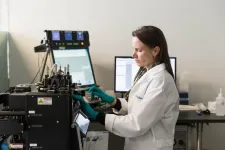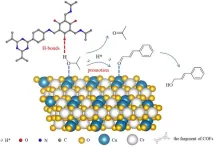(Press-News.org) A special kind of genetic test that helps determine the best antidepressant for patients with moderate-to-severe depression could generate substantive health system savings and greatly improve patient outcomes, according to new research from the University of British Columbia.
The study, published today in CMAJ, shows that in B.C. alone, implementing pharmacogenomic testing could save the provincial public health system an estimated $956 million over 20 years.
“Pharmacogenomic testing aims to match patients with medications that are more likely to be effective and cause less side effects, based on their genetic profile,” said co-senior author Dr. Stirling Bryan (he/him), professor at UBC’s school of population and public health, and senior scientist at Vancouver Coastal Health Research Institute (VCHRI). “Our findings show that the benefit to patients in B.C. could be enormous, including increased remission rates and better quality of life, while generating significant cost savings by keeping people out of hospitals and more intensive treatment pathways.”
One in 10 Canadians will experience major depression at some point in their lives, making it one of the largest public health burdens. While more than 35 antidepressant medications are available in Canada, over half of patients don’t respond to the antidepressant they are initially prescribed and roughly 27 per cent report adverse effects.
Previous studies have shown that up to 42 per cent of the variation in how patients respond to these medications is due to genetic factors. Pharmacogenomic testing uses genetic information, typically obtained using a cheek swab, blood test or saliva sample, to help guide medication selection and dosing.
“Genes play an important role in how our bodies metabolize different antidepressants, which ultimately influences their efficacy,” said co-senior author Dr. Jehannine Austin, professor of medical genetics and psychiatry at UBC. “The genetic insights provided by pharmacogenomic testing can help physicians make more informed treatment decisions and reduce the lengthy trial-and-error process that many patients experience in finding an effective medication.”
For the study, the researchers worked with patient partners, clinicians and health system and government partners to develop a simulation model that mimics the experience of patients with major depression, from diagnosis through to treatment, recurrence and recovery. By incorporating B.C. health administrative data, clinical trial data and defined treatment strategies, the model compared the projected journey of 194,149 adults with and without pharmacogenomic testing over a 20-year period.
The model showed that pharmacogenomic testing would result in 37 per cent fewer patients experiencing treatment-resistant depression, a situation in which the patients’ depression does not improve despite trying several kinds of treatment. Pharmacogenomic testing would also result in patients spending 15 per cent more time without depression symptoms, resulting in an anticipated 1,869 fewer deaths and 21,346 fewer hospital admissions over 20 years.
“By incorporating the perspectives of patients with lived and living experience into this model, alongside robust data sets, we are able to carefully simulate the treatment journey of people with major depression,” said first author Dr. Shahzad Ghanbarian, a mathematical modeler and health economist at the Centre for Clinical Epidemiology and Evaluation, a research group within the VCHRI and affiliated with UBC. “The simulation model is designed to be flexible and could be applied to other jurisdictions beyond B.C., where we might expect to see similar benefits, particularly within a comparable Canadian context.”
Linda Riches, who lives in Salmon Valley, B.C., has been living with major depression for over 30 years and was one of the patient partners who helped undertake the study.
“All people with major depression deserve to feel hopeful about their life. Genetic testing may give them the opportunity to know what treatment they need, not the 10 they didn’t need,” said Riches.
Pharmacogenomic tests are not currently offered through the public health systems across Canada, but patients can pay for them through private companies.
The researchers say their analysis makes a strong case for including pharmacogenomic testing as part of routine, publicly-funded health care for people with major depression in B.C., but more work is needed to determine how such testing could be put into practice.
“We’ve shown here this can be effective, and our next step is to figure out the best way to do it, with input from patients, physicians, government and health sector partners,” said Dr. Bryan. “Exploration of implementation strategies, such as which health-care professionals are best-suited to deliver pharmacogenomic testing, is the natural next step and remains unexplored in Canada.”
This study was funded by Genome BC, Genome Canada and Michael Smith Health Research BC.
Interview language(s): English
END
Genetic testing could greatly benefit patients with depression, save health system millions
2023-11-14
ELSE PRESS RELEASES FROM THIS DATE:
Geese ‘keep calm and carry on’ after deaths in the flock
2023-11-14
Canada geese strengthen existing friendships and forge a few new connections after losing close associates from their flock, new research shows.
University of Exeter scientists observed flocks of Canada geese before and after a population-management cull in which about 20% of the birds were killed.
In such a situation, some animals species increase “social connectivity” – mixing with many new individuals – which can increase the transmission of infectious diseases.
But the geese in the study responded by strengthening existing relationships, only adding enough new associations to replace those they had lost.
“Our findings shows that Canada geese are very ...
Using eclipses to calculate the transparency of Saturn’s rings
2023-11-14
A Lancaster University PhD student has measured the optical depth of Saturn’s rings using a new method based on how much sunlight reached the Cassini spacecraft while it was in the shadow of the rings.
The optical depth is connected to the transparency of an object, and it shows how far light can travel through that object before it gets absorbed or scattered.
The research, led by Lancaster University in collaboration with the Swedish Institute of Space Physics, is published in the Monthly Notices ...
Researchers propose MOF modular customization strategy for efficient membrane separations
2023-11-14
Membrane separation technology offers great potential due to its low energy consumption and continuous operation availability. Metal-organic frameworks (MOFs) are promising in separation membranes due to their abundant species, high porosity, and precise regulation of pore architectures.
Recently, a research group led by Prof. YANG Weishen and Assoc. Prof. PENG Yuan from the Dalian Institute of Chemical Physics (DICP) of the Chinese Academy of Sciences (CAS) has proposed a new strategy of modular customization and non-destructive ...
Scientists test new method for identifying small microplastics
2023-11-14
Microplastics, from the beads that were once commonplace in cosmetics to the weathered and broken-down remnants of trash, are now ubiquitous in marine and inland waters around the world. To date, though, scientists have struggled to identify which plastics persist longest in the environment and measure their abundance, especially at the smaller end of the size range where they’re most likely to be consumed by foundational species near the bottom of the food web, like zooplankton.
Researchers from Bigelow Laboratory for Ocean Sciences and the University of Minnesota ...
Tandem single atom electrocatalyst realizes reduction of CO2 to ethanol
2023-11-14
The electrochemical CO2 reduction reaction (CO2RR) into carbon-based fuels provides a promising strategy to mitigate CO2 emission and promotes the utilization of renewable energy.
The Cn (n≥2) liquid products are desirable because of their high energy densities and ease of storage. However, manipulation of C-C coupling pathway remains a challenge due to the limited mechanistic understanding.
Recently, a research group led by Profs. ZHANG Tao and HUANG Yanqiang from the Dalian Institute of Chemical Physics (DICP) of the Chinese Academy of Sciences (CAS) has developed a Sn-based tandem electrocatalyst (SnS2@Sn1-O3G), which could reproducibly yield ethanol ...
Overdose prevention sites not associated with increase in crime, according to study
2023-11-14
PROVIDENCE, R.I. [Brown University] — Overdose prevention centers, where individuals can consume illicit drugs under the observation of trained staff, are not associated with significant increases in crime, researchers found.
When the researchers compared syringe service programs in New York City with two programs that were recently sanctioned by city officials to offer supervised drug consumption, they found no significant increases in crimes recorded by the police or calls for emergency service in the surrounding neighborhoods.
The findings, which were published in JAMA Network Open, come as plans to open overdose prevention centers proceed in Rhode ...
H bond promoted hydride transfer
2023-11-14
The precise catalytic conversion of chemical bonds is a paramount goal in catalysis. Enzymes, as efficient biocatalysts, are well known for their high catalytic activity, selectivity, and substrate specificity under mild reaction conditions, which can be attributed to the synergistic catalysis of multiple active sites. Inspired by the catalytic mechanism of enzymes, the rational design of catalysts with multiple active sites to stabilize TS and accelerate the rate-determining step is a promising strategy for achieving high activity and selectivity.
However, integrating multiple active sites into a single catalyst without interference during the catalytic process remains an enormous ...
New neuroscience publication, The Transmitter, will inform and connect the field
2023-11-14
Today marks the launch of The Transmitter, a new publication focused on helping neuroscientists stay current on the latest developments in the field and build new connections.
Created by the team that brings Spectrum to autism researchers, The Transmitter will provide essential news, insights and resources across neuroscience disciplines and career stages. Spectrum will continue to publish news and perspectives on autism research as an anchor of The Transmitter. Like Spectrum, The Transmitter is an editorially independent publication of the Simons Foundation.
“Neuroscience discoveries are rapidly shifting our understanding of ...
Tulane researchers pioneer new strategy to help low-income patients control blood pressure
2023-11-14
Uncontrolled hypertension, the leading preventable risk factor for cardiovascular disease and premature deaths worldwide, disproportionately affects low-income populations.
Now, a new strategy that trains healthcare providers to deliver more comprehensive, team-based care has been found to significantly lower blood pressure in low-income patients compared to the “usual care” approach. The findings were reported by Tulane University researchers at this week’s American Heart Association Scientific Sessions in Philadelphia.
Tulane researchers conducted an 18-month clinical trial with 1,272 hypertension patients at 36 Federally Qualified Health Centers ...
Breast cancer cells collaborate to break free and invade into the surrounding tissue
2023-11-14
The majority of breast cancers start in the lining of a breast milk duct and, if they remain there, are very treatable. But once these cancers become invasive – breaking through a thin matrix around the duct, called the basement membrane, and spreading to the surrounding tissue – treatment becomes more challenging.
In a recent paper, published on Nov. 13 in Nature Materials, researchers at Stanford revealed a novel physical mechanism that breast cancer cells use to break out and become invasive. They found that, in addition to established chemical methods of degrading the basement membrane, cancer ...






